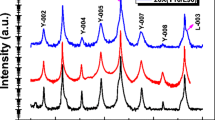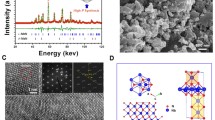Abstract
Using first-principles calculations, we predict the coexistence of mechanical superhardness and the controllable magnetism in the clathrate material β-C3N2 through the implant of the external atom into the intrinsic cage structure. Taking hydrogen-doping (H@β-C3N2) and fluorine-doping (F@β-C3N2) as examples, our calculations indicate these two doped configurations are stable and discover that they belong to antiferromagnetic semiconductor and ferromagnetic semi-metal, respectively. These intriguing magnetic phase transitions originate from their distinctive band structures around the Fermi level and can be well understood by the three-dimensional Hubbard model with half-filling occupation and the Stoner model. Moreover, the high Vickers hardness of 49.0 GPa for H@β-C3N2 and 48.2 GPa for F@β-C3N2 are obtained, suggesting they are clathrate superhard materials as their host. Therefore, the incorporations of H and F in β-C3N2 give rise to new types of superhard antiferromagnetic semiconductor and superhard ferromagnetic semimetal, respectively, which could have potential applications in harsh conditions. Our work provides an effective strategy to design a new class of highly desirable multifunctional materials with excellent mechanical properties and magnetic properties, which may arouse spintronic applications in superhard materials in the future.

摘要
基于第一性原理计算, 我们通过将客体原子嵌入β-C3N2笼状结构 的内在空腔中, 预测了机械超硬和可控磁性的共存. 以氢掺杂(H@β-C3N2)和氟掺杂(F@β-C3N2)为例, 我们的研究表明两种掺杂构型是稳定 的, 并发现它们分别属于反铁磁半导体和铁磁半金属. 这些有趣的磁相 变源于它们在费米能级周围独特的能带结构, 并可通过具有半填充占 据的3D Hubbard模型和Stoner模型很好地解释. 此外, H@β-C3N2和 F@β-C3N2的高维氏硬度(49.0和48.2 GPa)表明它们具有笼状超硬材料 特征. 因此, 氢和氟在β-C3N2笼中的掺杂分别产生了一种新型的超硬反 铁磁半导体和超硬铁磁半金属, 这些材料在极端条件下具有潜在的应 用前景. 我们的工作为设计具有优异机械性能和磁性的新型高性能多 功能材料提供了一种有效的策略, 这可能会为超硬材料未来在自旋电 子学的应用提供理论依据.
Similar content being viewed by others
References
Dolyniuk JA, Owens-Baird B, Wang J, et al. Clathrate thermoelectrics. Mater Sci Eng-R-Rep, 2016, 108: 1–46
Ma L, Yang X, Liu G, et al. Design and synthesis of clathrate LaB8 with superconductivity. Phys Rev B, 2021, 104: 174112
Somayazulu M, Ahart M, Mishra AK, et al. Evidence for superconductivity above 260 K in lanthanum duperhydride at megabar pressures. Phys Rev Lett, 2019, 122: 027001
Liu L, Wang C, Yi S, et al. Microscopic mechanism of room-temperature superconductivity in compressed LaH10. Phys Rev B, 2019, 99: 140501
Ma L, Wang K, Xie Y, et al. High-temperature superconducting phase in clathrate calcium hydride CaH6 up to 215 K at a pressure of 172 GPa. Phys Rev Lett, 2022, 128: 167001
Prokofiev A, Sidorenko A, Hradil K, et al. Thermopower enhancement by encapsulating cerium in clathrate cages. Nat Mater, 2013, 12: 1096–1101
Zhang Y, Brorsson J, Qiu R, et al. Enhanced Thermoelectric Performance of Ba8 Ga16 Ge30 Clathrate by Modulation Doping and Improved Carrier Mobility. Adv Elect Mater, 2021, 7: 2000782
Zhu L, Strobel TA, Cohen RE. Prediction of an extended ferroelectric clathrate. Phys Rev Lett, 2020, 125: 127601
Veprek S, Zeer A, Riedel R. Handbook of ceramic hard materials. Weinheim: Wiley-VCH, 2000. https://doi.org/10.1002/9783527618217
Wei Q, Zhang Q, Yan H, et al. A new superhard carbon allotrope: tetragonal C64. J Mater Sci, 2017, 52: 2385–2391
Li Z, Hu M, Ma M, et al. Superhard superstrong carbon clathrate. Carbon, 2016, 105: 151–155
Cui Z, Zhang X, Sun Y, et al. Prediction of novel boron-carbon based clathrates. Phys Chem Chem Phys, 2022, 24: 16884–16890
Li Y, Hao J, Liu H, et al. High-energy density and superhard nitrogen-rich B-N compounds. Phys Rev Lett, 2015, 115: 105502
Li X, Yong X, Wu M, et al. Hard BN clathrate superconductors. J Phys Chem Lett, 2019, 10: 2554–2560
Gou H, Dubrovinskaia N, Bykova E, et al. Discovery of a superhard iron tetraboride superconductor. Phys Rev Lett, 2013, 111: 157002
Zhou F, Liu Y, Wang J, et al. Intersecting topological nodal ring and nodal wall states in superhard superconductor FeB4. Phys Rev Mater, 2021, 5: 074201
Li S, Zhang J, Wang J, et al. Dense as diamond: Pn-C10, a superhard sp 3 carbon allotrope. Appl Phys Lett, 2021, 118: 012107
Dai J, Tian Z. Large thermal conductivity of boron suboxides despite complex structures. Appl Phys Lett, 2021, 118: 041901
Liang Y, Zhang X, Xu M, et al. Superconductivity in clathrate LiLaB8 with nontrivial band topology. Mater Today Phys, 2022, 27: 100817
Qian Y, Wu H. D-C4N3: a superhard ferromagnetic half-metal predicted by first-principles study. Phys Lett A, 2022, 423: 127814
Jiang X, Zhao J. Evolution of boron clusters in iron tetraborides under high pressure: semiconducting and ferromagnetic superhard materials. RSC Adv, 2015, 5: 48012–48023
Ma S, Farla R, Bao K, et al. An electrically conductive and ferromagnetic nano-structure manganese mono-boride with high Vickers hardness. Nanoscale, 2021, 13: 18570–18577
Zhao X, Li L, Bao K, et al. Synthesis and characterization of a strong ferromagnetic and high hardness intermetallic compound Fe2 B. Phys Chem Chem Phys, 2020, 22: 27425–27432
Manyali GS. Ab initio study of structural properties and dynamical stability of C3N2 encapsulating H guest atom. 2021, doi:https://doi.org/10.48550/arXiv.2110.12524
Kresse G, Furthmüller J. Efficient iterative schemes for ab initio total-energy calculations using a plane-wave basis set. Phys Rev B, 1996, 54: 11169–11186
Perdew JP, Burke K, Ernzerhof M. Generalized gradient approximation made simple. Phys Rev Lett, 1996, 77: 3865–3868
Togo A, Tanaka I. First principles phonon calculations in materials science. Scripta Mater, 2015, 108: 1–5
Gonze X, Lee C. Dynamical matrices, Born effective charges, dielectric permittivity tensors, and interatomic force constants from density-functional perturbation theory. Phys Rev B, 1997, 55: 10355–10368
Hill R. The elastic behaviour of a crystalline aggregate. Proc Phys Soc A, 1952, 65: 349–354
Di Cataldo S, Qulaghasi S, Bachelet GB, et al. High-Tc superconductivity in doped boron-carbon clathrates. Phys Rev B, 2022, 105: 064516
Dopilka A, Ovchinnikov A, Childs A, et al. Understanding the Li and Na intercalation in Si clathrate frameworks. Meet Abstr, 2021, MA2021-02: 226
Rey N, Muñoz A, Rodríguez-Hernández P, et al. First-principles study of lithium-doped carbon clathrates under pressure. J Phys-Condens Matter, 2008, 20: 215218
Kakehashi Y, Hasegawa H. Magnetic phase diagram of the half-filled Hubbard model for a simple cubic lattice. Phys Rev B, 1987, 36: 4066–4069
Brandow BH. Electronic structure of Mott insulators. Adv Phys, 1977, 26: 651
Majumdar K, Datta T. Zero temperature phases of the frustrated J 1–J 2 antiferromagnetic Spin-1/2 Heisenberg model on a simple cubic lattice. J Stat Phys, 2010, 139: 714–726
Li M, Wang Q, Wang G, et al. Dirac cone, flat band and saddle point in kagome magnet YMn6Sn6. Nat Commun, 2021, 12: 3129
Laubach M, Joshi DG, Reuther J, et al. Quantum disordered insulating phase in the frustrated cubic-lattice Hubbard model. Phys Rev B, 2016, 93: 041106
Motta M, Genovese C, Ma F, et al. Ground-state properties of the hydrogen chain: dimerization, insulator-to-metal transition, and magnetic phases. Phys Rev X, 2020, 10: 031058
Stoner E C. Collective electron ferronmagnetism. Proc R Soc Lond A, 1938, 165: 372–414
Cao T, Li Z, Louie SG. Tunable magnetism and half-metallicity in hole-doped monolayer GaSe. Phys Rev Lett, 2015, 114: 236602
Mouhat F, Coudert FX. Necessary and sufficient elastic stability conditions in various crystal systems. Phys Rev B, 2014, 90: 224104
Chen XQ, Niu H, Li D, et al. Modeling hardness of polycrystalline materials and bulk metallic glasses. Intermetallics, 2011, 19: 1275–1281
Pugh S F. XCII. Relations between the elastic moduli and the plastic properties of polycrystalline pure metals. London Edinburgh Dublin Philos Mag J Sci, 1954, 45: 823–843
Acknowledgements
This work was supported by the National Natural Science Foundation of China (12204330) and Sichuan Normal University for financial support (341829001).
Author information
Authors and Affiliations
Contributions
Author contributions Chang J conceived this research. Sun L performed the investigation and the corresponding calculations. Fu B and Chang J contributed to the theoretical analysis. All authors contributed to the general discussion.
Corresponding author
Ethics declarations
Conflict of interest The authors declare that they have no conflict of interest.
Additional information
Supplementary information Experimental details and supporting data are available in the online version of the paper.
Liping Sun is a master student at the School of Physics and Electronic Engineering, Sichuan Normal University. Her research interests mainly focus on the DFT calculations regarding superhard and magnetic materials and their applications.
Electronic Supplementary Material
Rights and permissions
About this article
Cite this article
Sun, L., Fu, B. & Chang, J. First-principles predictions of new superhard magnetic clathrate material β-C3N2 through atom embeddedness. Sci. China Mater. (2024). https://doi.org/10.1007/s40843-024-2916-5
Received:
Accepted:
Published:
DOI: https://doi.org/10.1007/s40843-024-2916-5




